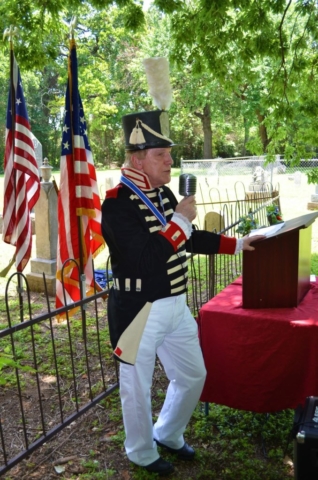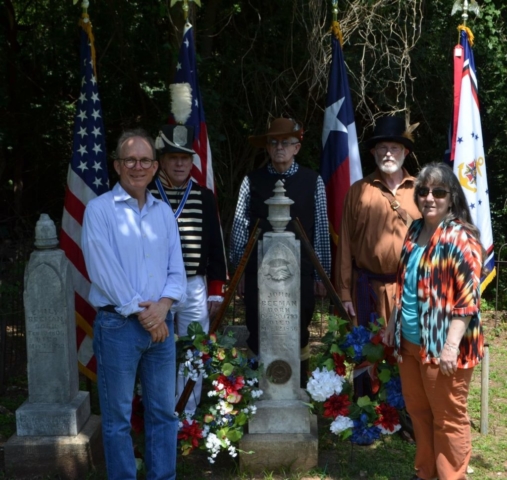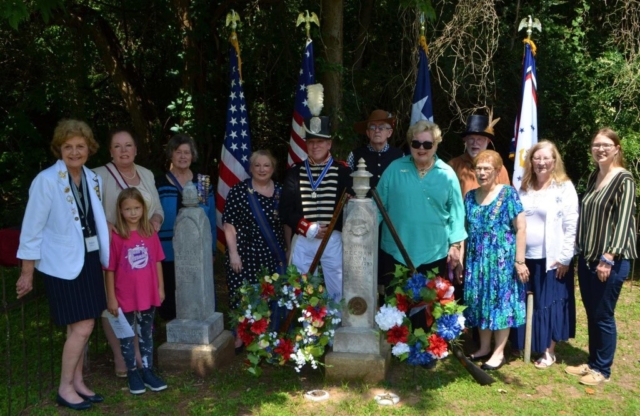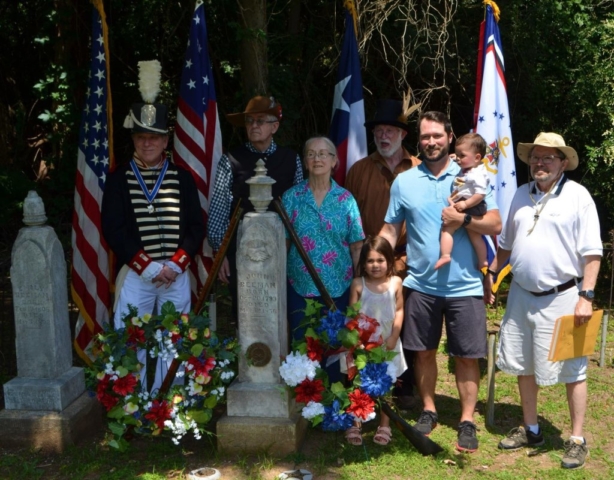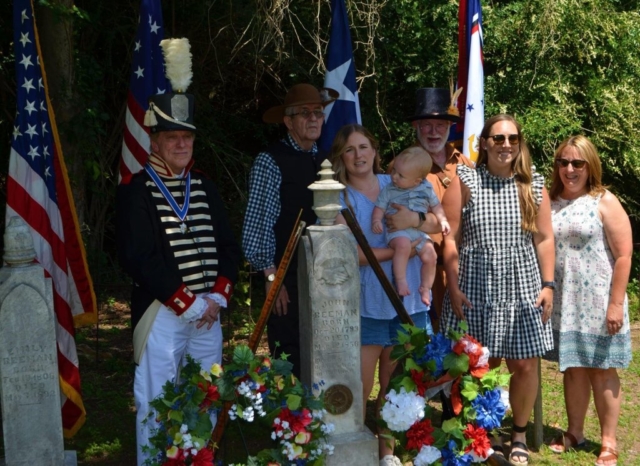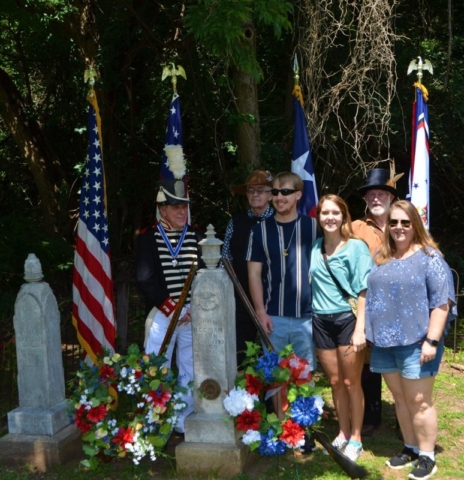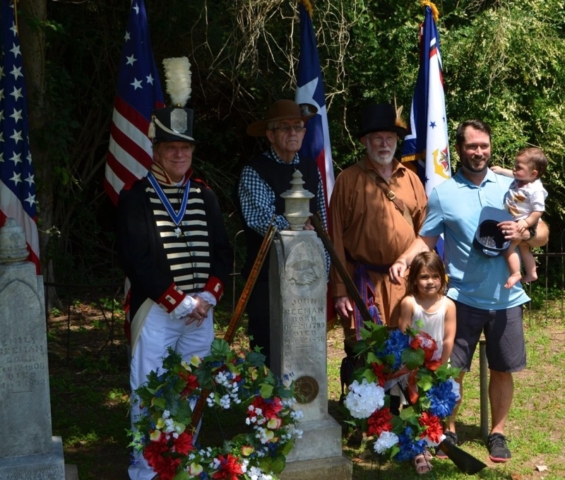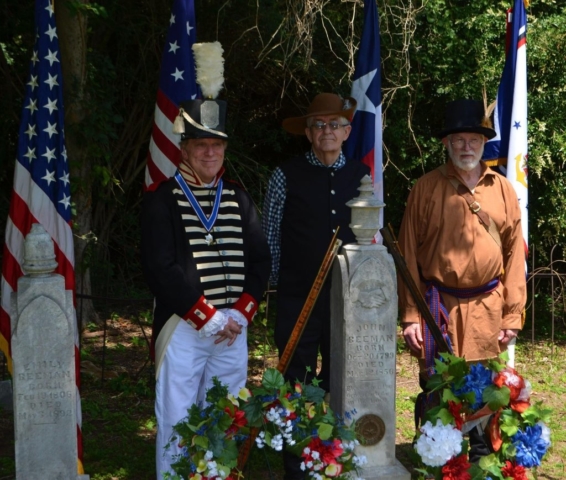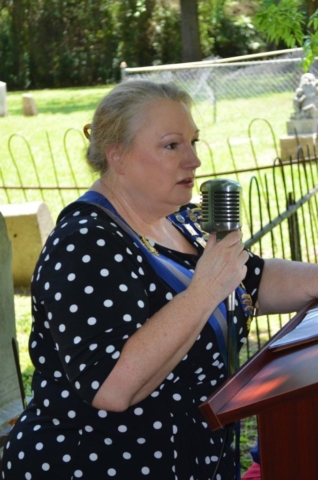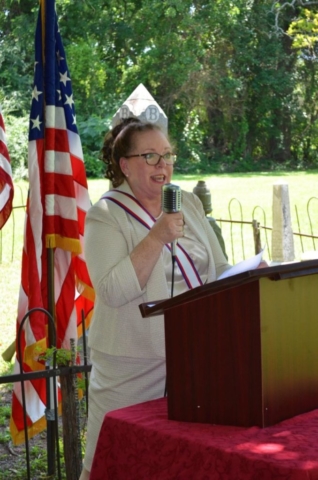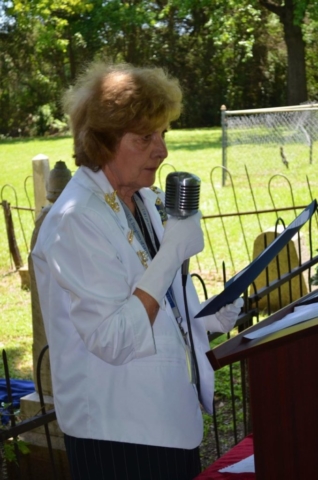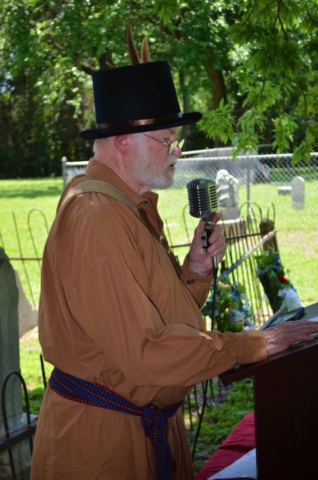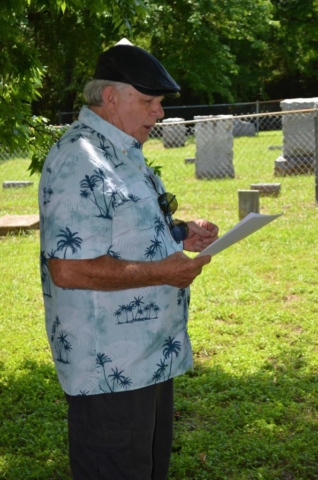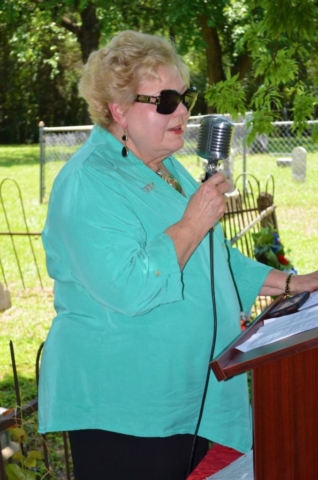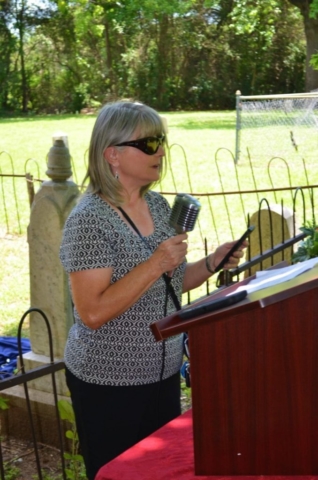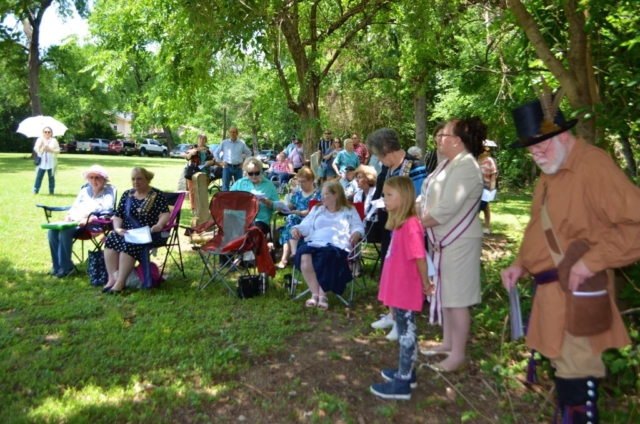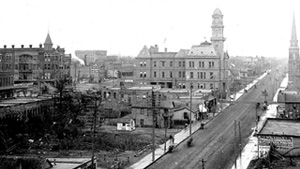On Sunday, June 5, 2022 at the Beeman Memorial Cemetery the Craig Austin Rowley Chapter, The Society of the War of 1812 in the State of Texas, and the John Cavet Chapter of the United States Daughters of 1812 honored John Beeman (1799-1856) for his service in the War of 1812. Several members of the Beeman family were in attendance. John Beeman was the second son of James Jackson Beeman and Nancy Moore Beeman and the younger brother of Samuel Sylvester Beeman.
(all photos courtesy of Paul Ridenour)
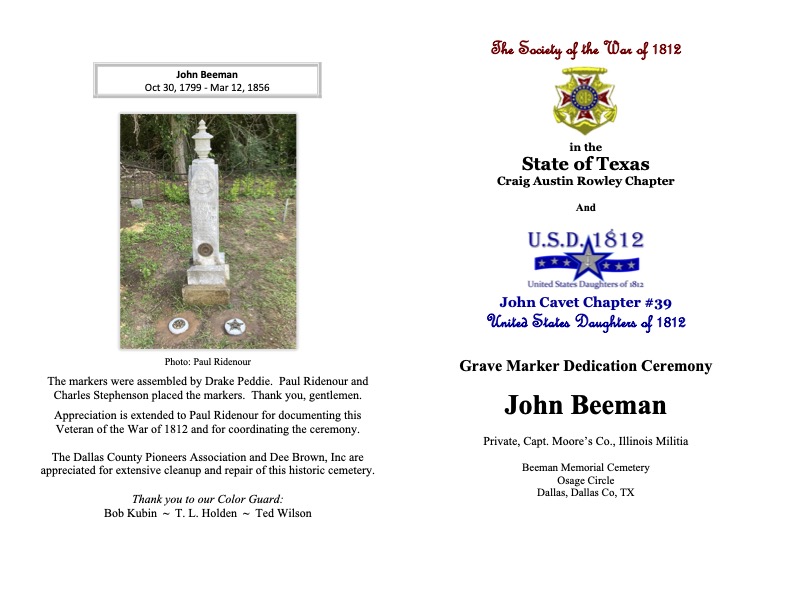

Biography of John Beeman by Beeman Descendant, M. C. Toyer:
John Beeman (1799 – 1856)
M C Toyer, June 5, 2022 – Dedication of War of 1812 Medallion for Private John Beeman
John Beeman, born in 1799, was just a child when his parents, James and Nancy (Moore) Beeman, and his siblings left their home on Dutchman’s Creek and set out on a journey of several years that would take them to the far western boundary of the United States. They were accompanied at times by Nancy’s brothers, George, William and Abel Moore, and their parents John D and Nancy (Roberts) Moore Sr.
The opening of the Northwest Territory for settlement (the area north of the Ohio River, east of the Mississippi River and south of the Great Lakes) may have been their destination as the eastern seaboard states became increasingly crowded and suitable farmlands became scarce. Some accounts suggest they may have been following the lead of Daniel Boone who moved his family to the future Missouri Territory in 1799 before it was a part of the United States.
It would be an arduous and dangerous trek. They started northwest from their homes in North Carolina through Virginia to the Cumberland Gap then into Kentucky. There were extended stops along the way to plant, raise and harvest crops, join churches, and to birth and bury children. Beyond Kentucky there were not any established roads – just frontier trails and the paths used by Native Americans and wild animals and faint traces of military campaigns.
During the long journey the Louisiana Purchase doubled America’s territory. Lewis and Clark spent the winter of 1803 – 1804 at Wood River on the Mississippi just across from St Louis before their epic expedition to explore and map the new acquisition and travel to the Pacific Ocean, the western edge of the continent. The next year Daniel Boone’s sons established a road and settlement at Boons Lick, 150 miles west of St Louis.
The Moore brothers and their parents reached the Mississippi River about 1806 and continued on to Boons Lick. Nancy and John Moore Sr died there in 1808 and their sons later returned to Wood River to settle. James Beeman and his family had arrived at Wood River about 1807 and another child was born there in 1808. In 1809, the Beeman, Moore and Rattan families were among the founding members of the Wood River Primitive Baptist Church.
The ever present danger from Native Americans escalated with the flow of new settlers. Volunteer militias were raised and stockades built for the families’ protection. During the War of 1812 the British further empowered and stirred the Native Americans.
In the spring of 1813, John Beeman enlisted for a term of 3 months in Lieutenant Daniel Gaines Moore’s Volunteer Militia Company which also included John’s father James, brother Samuel, and his uncles George and Able Moore. Daniel Moore (not directly related to the Moore brothers) was an experienced soldier who had previously served as a private then sergeant beginning in 1811 and later as a Captain and Regimental Quartermaster.
In July 1814, a horrendous event known as the Wood River Massacre occurred. Six children and a young pregnant mother were killed in a single brutal attack on their way home from church. The children were all John’s younger cousins. Their fathers were away on militia duty and the other mothers at home preparing for the evening meal.
Abel and Mary Moore: sons William 9 and Joel 6; William and Margaret Moore: sons John 10 and George 7; Reason Reagan: wife Rachel 24, daughter Elizabeth 7, son Timothy 3, and an unborn child. All were scalped and mutilated and their bodies stripped of clothing.
The attackers were soon pursued by the militia under Captain Samuel Whiteside and a fight ensued in which several Indians were killed. Some believe that Reason Reagan was also killed in the fight. Mrs. Reagan’s scalp was found in a pouch on an Indian body. The massacre victims were buried in the Vaughan Cemetery at Wood River in three graves, one for each family.
As John Beeman and his siblings grew to adulthood their father James engaged in farming and expanded his properties. His wife Nancy passed in 1811 and he married Talitha (Rattan) Odle in 1815.
When was 17, John Beeman began purchasing public domain lands from the United States Government for $1.25 an acre in Green and Calhoun Counties. By then the Beeman family had moved north from Wood River to the area between the Mississippi and Illinois Rivers which had been set aside for War of 1812 Bounty Lands. In 1821, John and his father built a saw mill and grist mill on Apple Creek. John and his brother William later established a wood lot and a ferry in the town of Newport on the Illinois River.
In 1823, John Beeman married Emily Manley Hunnicutt, daughter of a large family that had recently emigrated from South Carolina. 8 children were born to this union in Illinois and 3 more in Texas. Their expanding family and the increasing local population led John to look for better opportunities, just as his father had before him.
Relatives and neighbors who had traveled to Texas since before the 1836 Revolution sent back reports of cheap and free land available to immigrants. In 1837 in Illinois, John Beeman purchased a certificate that entitled him to claim 640 acres in Texas for 15 cents an acre. Large tracts were offered free to settlers who built a cabin and made improvements to the land.
After the fall harvest in 1840, John Beeman sold most of his Illinois property to his brother William for $5000 and with his family and step brother James Jackson Beeman and their nephew John S Beeman and their families and several other relatives and neighbors set out for a new beginning in the Republic of Texas. They crossed the Red River on December 6, 1840. Brother Samuel Beeman and brother-in-law William Hunnicutt and their families would follow in 1846 and other Hunnicutt and Moore relatives later joined them.
The first order of business was to set up camp then rent land for the spring crops near Dalby Springs in far northeast Texas. The adult males and heads of families registered for their Headright Grants.
Once again on the frontier atrocities by Native Americans were committed upon the new settlers. The men and boys joined various militia and ranger units which traveled to the Three Forks to confront the problems. In the fall of 1841 Captain Alexander W Webb’s Militia Company established Bird’s Fort in present Arlington and were soon joined by their families to create a settlement and buffer for protection of the Military Road and settled lands to the east. Those from Illinois included single men Alexander W Webb, Howell Blythe Dowdy, King S Custer, Henry C Long, the Cox and Moore brothers, and the Wade H Rattan, Henry Hahn, Solomon Silkwood and multiple Beeman families.
At the same time the empresario Peters Colony land grant was expanded to encompass the fort site and the militia and settlers were forced to abandon the area. The Beeman clan and several others agreed to join John Neely Bryan at his lone outpost on the Trinity River at a place which became Dallas.
John Beeman chose to push farther east and selected land on White Rock Creek for his homestead. A blockhouse was built for protection immediately on arrival in early April 1842, then cabins were erected and crops planted.
John and Emily Beeman’s daughter Margaret would marry Bryan in 1843. John Beeman, with his experience and vision, would partner with Bryan to establish a ferry and promote navigation on the Trinity River to the Gulf of Mexico, but John Beeman’s primary role was a farmer and small businessman. He chose his lands to sustain his family and with an eye on commercial value.
- Lagow League: Homestead where ancient Indian and game trails crossed White Rock Creek later known as Scyene Road Across this 640 acre homestead the Central National Highway was surveyed in 1844-45, Texas and Pacific Railway in 1873, Texas Hwy 15 and US 80 in early 20th century, and the Dallas and Terrell Interurban in 1922
- East of White Rock Creek: Big Spring, Prairie, Cedar Break 320 acre tracts
- Dallas: Directly across Trinity from Bryan and directly south of Bryan 320 acre tracts When Texas became a state in December 1845, John Beeman was selected by a committee of Dallas citizens to petition the new Legislature for the creation of a county. As there was not yet a county for him to represent he was rebuffed but the representative from Robertson County presented the petition on his behalf. When it was approved son William Hunnicutt Beeman rode his mustang pony to Franklin and back to obtain the document.
There are no photographs of John Beeman but in his widow Emily’s pension application he was described as being 5 foot 9 inches tall, dark complexion, black hair, and dark brown eyes, whose occupation was a farmer. We do not know how John Beeman died. It seems he became ill several years before his death in 1856. In November 1853 he deeded his homestead to his wife Emily which she later parceled out to her surviving ten children. He sold his 320 acre tract west of the Trinity from Bryan to Alex Cockrell. The balance of John Beeman’s estate was distributed equally to his children after his death by his executor William C Hunnicutt.
John Beeman was a true American pioneer who honored and served his country and benefitted from its vastness and opportunities for those who would accept the challenges. His ancestors and descendants participated in every war, insurrection and threat to guarantee those freedoms and liberties. That noble tradition continued through the generations.


